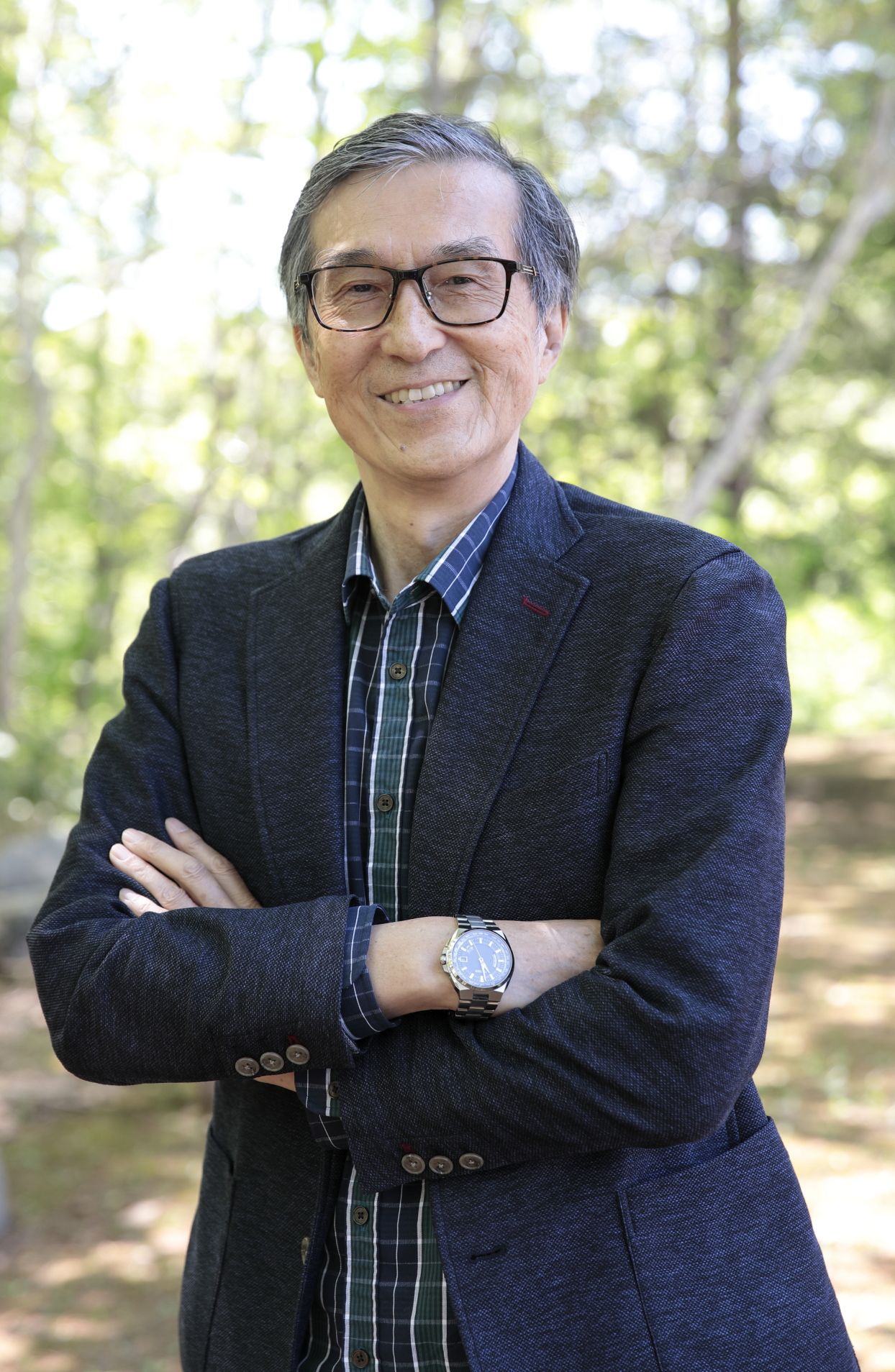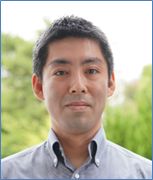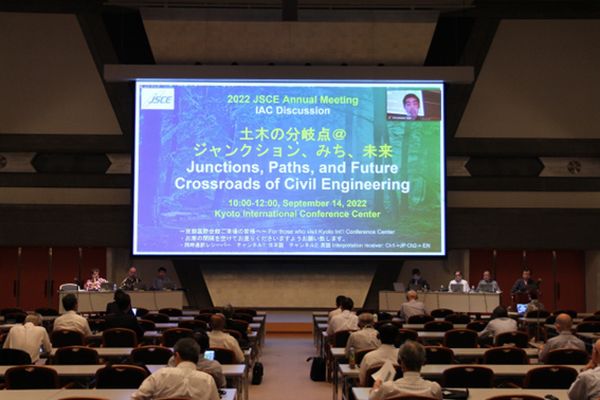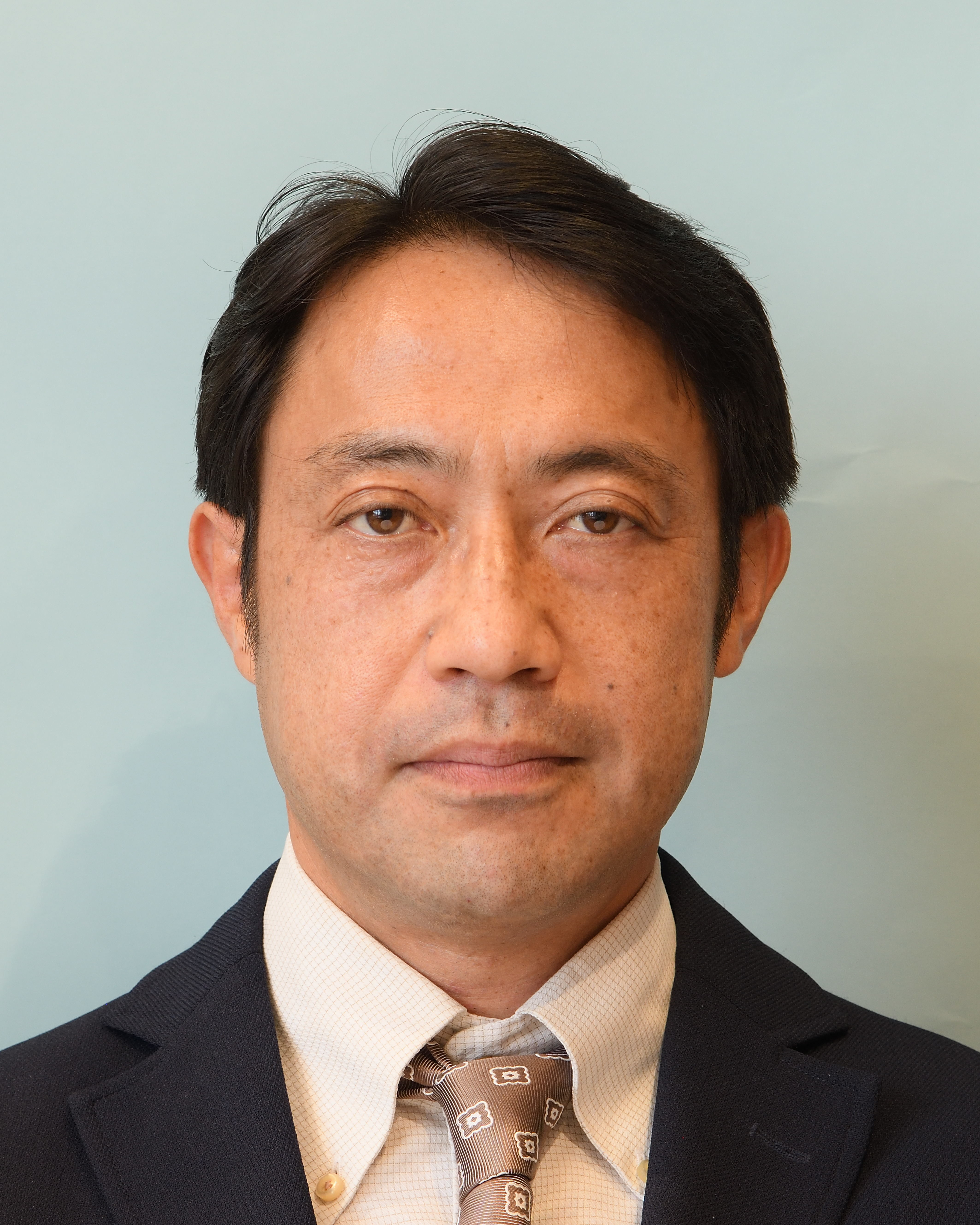IAC News
IAC News No.122, December 2022
Japan Society of Civil Engineers International Activities Center December 1, 2022 IAC News No.122
Japan and Its Need to Increase Its Number of Global Civil Engineers

Tamon Ueda
(110th President of the Japan Society of Civil Engineers)
*Photographer: Rumiko Ito
The construction industry in Japan was a world-leader in the 1990s. As an earthquake-prone country, Japan’s earthquake-resistant technologies are examples of top-level construction technologies recognized around the world. However, compared to the other major countries in the world, Japan’s percentage of overseas projects is small, making up only a few percent of its total projects. In other words, the percentage of Japanese civil engineers working overseas is small. Compared to other countries, the percentage of Japanese civil engineers who move overseas and work for an overseas company is also small. This can be said for Japanese across the border and not just those in the construction industry. Japanese based overseas are only 1% of the population, a small percentage when compared to other major countries in the world.
The reason why the percentage of Japanese working overseas is small is common knowledge; it stems from lacking English proficiency. This point was also made evident in an annual survey of civil engineering students at Hokkaido University, where I used to teach. Furthermore, it was observed that as a civil engineer, it is difficult to acquire the qualifications required overseas due to how the job market works in Japan. Another point that must be remembered is that many Japanese believe that living in Japan is better than living in another country and so cannot find a reason to live overseas. This is so-called introverted thinking. This point was also highlighted in the survey of civil engineering students at Hokkaido University.
Is this set of circumstances really a good thing? The civil engineering field has a close connection with global issues. In terms of decarbonization, the construction industry is responsible for about one-third of carbon dioxide emissions. It is obvious that civil engineering must take action globally. In the years to come, construction projects will be rolled out in developing countries, and many of these projects will be international. It is obvious that we must deploy construction projects with a worldwide perspective. In developed countries, the age of building infrastructure is over and we are entering an era of maintenance and repair. We cannot hope for an increase in construction projects like in the past. The involvement of major developed countries in construction projects overseas is normal. Why is Japan the exception? We should completely change this situation in which we are satisfied with just the domestic market in Japan with its constant demand for construction due to reconstruction from natural disasters. I wish Japan, as an industrial nation, would learn by observing other industries deploying projects across the globe.
I am not saying that the majority of Japanese construction projects should be done overseas. I believe we should start by increasing the current number of projects by about two or three-fold, and that it is natural for Japan, which has construction technologies equivalent to that of other developed countries, to have 10 to 20% of its projects as overseas projects. Civil engineers needed for this are Japanese and international civil engineers working in Japan, and in addition, overseas civil engineers working in partnership with Japanese companies. For this, we need initiatives spanning industry, government, and academia to formulate strategies in the public and private sectors, improve the treatment of human resources with career experience internationally in public and private organizations, and showcase global projects and civil engineers to students. Focusing predominantly on young civil engineers, JSCE currently provides schemes for civil engineers to develop themselves into global civil engineers. The Subcommittee for Making Civil Engineers More Internationally -Minde (Chairperson: Keitaro Konuma), which is one such example, holds lively discussions that also include female and international civil engineers. I hope we will see the fruits of these efforts in the years to come.
IAC Discussion: Junctions, Paths, and Future, Crossroads of Civil Engineering
 Assoc. Prof.
Assoc. Prof.
Hiromasa Iwai
(Kyoto University)
The IAC Discussion was held in Room A of the Kyoto International Conference Center on Wednesday, September 14 from 10:00 to 12:00. The event was held both in-person and streamed online via Zoom, offering simultaneous interpretation. There were 315 attendees in total.
The keyword of the event was “crossroads.” This event is an initiative to consider the course that the civil engineering field should take in order to solve various problems facing all humankind that cannot be solved by conventional civil engineering, which has been concerned with establishing a civilized society.
The first half welcomed guest speakers Professor Yozo Fujino, representing JSCE, Ms. Jane Howell and Ms. Eva Lerner Lam from American Society of Civil Engineers (ASCE), and Dr. Chen Xiangsheng from China Civil Engineering Society (CCES) for keynote lecturers. They gave talks on the huge civil engineering projects that ASCE and CCES are working on, including the major crossroads they have experienced personally so far. Unfortunately, as the connection for Dr. Chen Xiangsheng’s lecture was poor, we were not able to enjoy his full talk within the allotted time. I hope to create another opportunity for him to give his keynote lecture.
The second half of the event consisted of a panel discussion in which relatively young civil engineers and researchers, who will carry the future of the civil engineering industry and society, took to the stage, together with Prof. Tamon Ueda the JSCE president and 4 keynote speakers. The panelists were the four experts of Mr. Shuji Hashizume (Asian Development Bank), Mr. Tatsuhito Kondo (JICA), Mr. Lewis Benjamin (Obayashi Corporation), and Associate Professor Jan-Dirk Schmoecker (Kyoto University). In addition to themes directly related to civil engineering, such as global climate change, preparations for and recovery from increasingly severe natural disasters, discussions also focused on how civil engineering can be used to eliminate the economic and regional disparities that arise between urban and suburban areas, as well as the economic disparities between developed and developing countries. In particular, I learned a great deal from the discussions on the importance of balanced investment in civil engineering projects and promoting civil engineering projects as part of government policies, which were topics considered from not just a civil engineering perspective but also from the perspective of the finance industry.
The International Program that has been a part of the JSCE Annual Meeting to date, was done under the name “International Roundtable Meeting” (RTM). As the RTM is done in English, it did not appear to be intended for general attendees or students to stop by and listen casually to what was discussed. But at this year’s Kyoto event, which was the first time for us to hold in both in-person and online modes, providing simultaneous interpretation, I am convinced it was a session in which students and general attendees could also take an interest and casually listen in. I am really pleased that the International Program, which was held for the first time in two years, was done with this new approach, and I really hope that it served as a fantastic opportunity for greater networking with overseas civil engineering associations going forward.

【Reported by Associate Prof. Hiromasa Iwai, Kyoto University 】
The 6th Seminar on the Internationalization of Technical Standards:
‘Road and Bridge Asset Management Deployment Overseas - Laos Case Study’
On September 27, 2022, the 6th Seminar on the Internationalization of Technical Standards: ‘Road and Bridge Asset Management Deployment Overseas - Laos Case Study’ was held by the JSCE International Activities Center. Based on the trends of the internationalization of technical standards, this event has been held five times under themes such as roads and ports, with the aim of providing useful information to on-site civil engineers working in Japan or overseas.
Asset management in social infrastructure is the concept of “positioning social infrastructure as an asset of the nation, and maintaining and increasing the value of that asset systematically and strategically.” It is a way of thinking that was born out of the 1980s when the insufficient maintenance and repair of infrastructure became a problem in the United States.
The demand for infrastructure maintenance in developing countries is strong, and nowadays Japan as a nation is promoting the deployment of its infrastructure initiatives overseas. In advancing the overseas deployment of infrastructure, it is important not only to build structures and pass them on to developing countries, but also to roll out Japan’s construction technologies and improve the skills of engineers in developing countries.
That is why, under the theme of the road and bridge asset management deployment overseas, this time I decided to introduce case studies of each road and bridge sector.
The seminar began with opening remarks from Senior Vice President of the Japan International Cooperation Agency Seiichi Onodera, followed by a lecture on the trends of overseas deployment strategies of roads and bridges by Director for Overseas Road Projects Hiromichi Kitama of the International Affairs Office, Planning Division, Road Bureau, Ministry of Land, Infrastructure, Transport and Tourism (MLIT).
The seminar also featured talks by General Manager Yoshimoto Koyanagi and expert Tatsuhito Kondo of the Infrastructure Engineering Department at Japan International Cooperation Agency about JICA’s road asset management support in developing countries as well as JICA’s “Project for Strengthening Capacity for Maintenance of Roads and Bridges” in Laos.
In addition, Associate Professor Takafumi Nishikawa of the Graduate School of Engineering at Nagasaki University discussed examples of research and research projects being tackled in Laos by Nagasaki University.
At the end of the symposium, Yoshiaki Higuchi, Director of the International Activities Center, gave a summary of the event’s proceedings.
Along with the introduction of each project, there was a lively question and answer session, making it a seminar packed with content. The seminar was held online and in-person, and with a strong interest in infrastructure asset management, received advanced applications from 353 attendees.
I hope the seminar served as a forum for providing lots of useful information to civil engineers working in Japan or overseas and for contributing to the deployment of Japan’s construction technologies in developing countries.
This is the sixth time the seminar has been held since it was first held back in 2018. I would like to ask for your continued support as well as your thoughts regarding the symposium so that I can continue to deliver a successful event to all attendees.
【Reported by Jun Kunihiro, Japan International Cooperation Agency 】
The 11th Civil Engineer’s Lounge “DOBOKU”

Yuji Munehiro
(CHODAI CO., LTD.)
The lecturer at the 11th Civil Engineer’s Lounge “DOBOKU” was Senior PPP Officer Masayuki Kanda from the multilateral development bank (MDB) Asian Development Bank (ADB), who gave his lecture online from Manila in the Philippines. The title of the lecture was “Introduction to the Asian Development Bank’s PPP Initiatives for Facilitating Infrastructure Development in Developing Countries,” and was attended by one person in person and 20 attendees online.
The content of the lecture was extremely detailed, covering topics such as an overview of ADB’s business, the need for infrastructure in Asia, the lack of investment in infrastructure and the use of PPP (Public-Private Partnership) initiatives to fill this void, the role of ADB in undertaking PPP projects, as well as a look at PPP project cases in depth. The most shocking part of the lecturer was that although there is a huge investment demand of 1.7 trillion USD annually in Asia, the existing infrastructure budget covers approximately only 40% of that, and to make up for the remaining 60% of insufficient investment, there is a need for public-sector investment by way of PPP.
Mr. Kanda explained in an easy-to-understand manner that for Japanese construction companies to enter the infrastructure market in Asia, there is the new PPP market in addition to the existing Official Development Assistance (ODA) market. PPP, however, comes with all kinds of risks in addition to capital risks, and so to manage these risks appropriately, ADB has prepared support measures for each business phase.
The second half of the lecture was a lively Q&A session, and there was also mention of the fact that the needs of ADB had changed during the COVID-19 pandemic, with a particular increase in hospital infrastructure. There was a lot of feedback from attendees, including in the post-lecture survey, that said that the lecture was extremely valuable. Attendees got to learn in-depth about ADB, which they were not particularly familiar with, and there were even calls for ABD to enhance its promotion of Japanese companies. I can happily say that this event proved to be a big success.
【Reported by Yuji Munehiro Professional Development and Education Program Group,
(CHODAI CO., LTD.) 】
Updates
◆JSCE-ASCE Infrastructure Resilience Research Group
https://www.infraresil.jp/
◆The 4th International Conference on Transportation Infrastructure and
Sustainable Development (TISDIC 2023)
https://tisdic2023.dut.udn.vn/
◆International Joint Seminar of VJU and NILIM
- Introduction of Road Technology and Policy Making –
https://www.jsce-int.org/node/785
◆JSCE Feedback Web Form「多門に多聞&多問」
https://committees.jsce.or.jp/chair/node/59
◆The International Infrastructure Archives
– A Compilation of Japan’s Greatest Projects in Transfer of Civil Engineering Technology in Service –
http://www.jsce.or.jp/e/archive/
◆JSCE Concrete Committee International Newsletter No. 66
https://www.jsce.or.jp/committee/concrete/e/newsletter/newsletter66/index.html
◆IAC “News Pick Up!!” on the JSCE Japanese website
https://committees.jsce.or.jp/kokusai/iac_dayori_2022
◆Summary of featured articles in JSCE Magazine Vol. 107, No.12 December 2022
http://www.jsce-int.org/pub/magazine
◆Journal of JSCE
https://www.jstage.jst.go.jp/browse/journalofjsce
◆The 4th Asian Concrete Federation (ACF) Symposium on Emerging Technologies for Structural Longevity (ACF2022_ETSL): https://acf2022.aconf.org/index.html
◆The 9th International Conference on Flood Management (ICFM9)
https://www.icfm9.jp/index.html
◆Breakwaters 2023
https://www.ice.org.uk/breakwaters <https://www.ice.org.uk/breakwaters
Subcription
The IAC News is one of the communication tools to share information and ideas with the members. We would like to invite you, your friends and colleagues to join the communication and to subscribe the IAC News. Please register online: (http://www.jsce-int.org/node/150). We look forward to meeting you.
